Logitech G5 Laser Mouse: When an update is not worthy of a new name
by Gary Key on July 25, 2007 12:01 AM EST- Posted in
- Peripherals
Software Features
Logitech ships version 3.3a of their SetPoint software suite in the current G5 package. Based upon our early testing in Vista, we just recommend using the CD as a platter and instead download version 4.00 before you use the mouse although the basic mouse functions work fine with the included drivers. Logitech's software installation is painless, but required about 58MBs of disk space, and also searched for other Logitech hardware for updates. The software supports Windows XP, XP-64 Edition, Vista 32 or 64-bit, and MacOS X. The basic mouse functions worked fine in SUSE Linux 10.2 but SetPoint is not compatible with Linux at this time.
The primary purpose of SetPoint is to allow complete control over the mouse's hardware capability. The interface is fairly intuitive and the programs offers a dizzying array of options to control the wheel and various buttons on the mouse. This includes an informative status display for checking the dpi and USB polling rates in the gaming section . While we could spend pages on describing and showing each setting we will simply display the configuration windows and recap any major items of interest we discovered during testing.
Once we loaded the software and rebooted, our first order of business was to understand how memory hungry the SetPoint application and associated software is in Vista Home Premium. The results were surprising when compared to our MX Revolution that consumed around 18MB of memory when active. Our two Logitech programs, Khalmnpr.exe and Setpoint.exe, consumed a total of 8.5MB of memory in idle state and 12MB of memory while active. CPU usage was nominal during all phases of testing although we have heard reports of reduced frame rates in some configurations.
The first option screen allows the user to define the function of the scroll wheel along with each button except for the right and left click buttons. A listing of the more common commands is listed at the right of the screen with additional options available if you choose the "Other" option. Each configurable button on the mouse has its own display screen and option choices. Logitech highlights and provides a picture zoom of the button or wheel you are adjusting. If you want the mouse to follow a different set of commands in a particular program then you simply select the supported program from a drop-down list and reassign the buttons. This feature is probably one of the most widely used and if the program is not available you can manually add it.
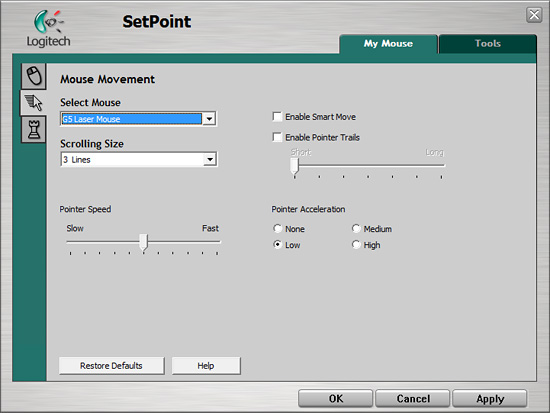
The Mouse Movement section allows for pointer adjustments and is quicker to use than the standard Windows mouse option screen.
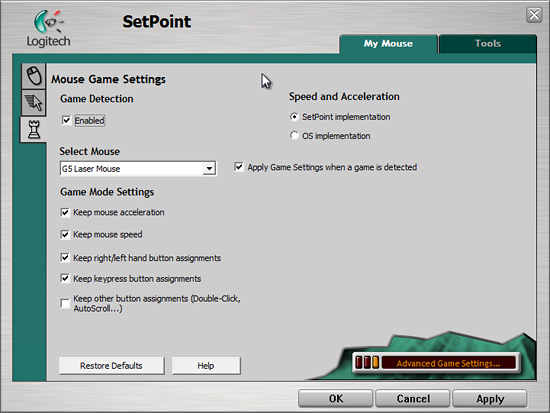
The Mouse Game Settings section allows for OS or SetPoint control of basic speed, acceleration, and button settings if a game is automatically detected.

The Advanced Game Settings section allows for complete control over Mouse Sensitivity along with USB (refresh rates) reports per second settings. You can configure up to five different dpi sensitivity settings between 400 and 2000 DPI although only three are available for the button assignments. You can also set the horizontal and vertical sensitivities separately. USB reports per second settings are available from 125 up to 1000 in six different rates. The mouse defaults to 500, a number we found was just about perfect from both a performance and compatibility aspect across a wide range of systems. The SetPoint software will setup basic profiles for games that it recognizes. These profiles can then be customized or you can setup individual profiles for games that are not recognized.
 |
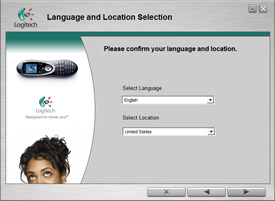 |
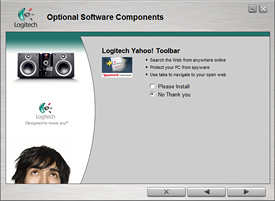 |
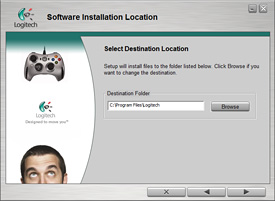 |
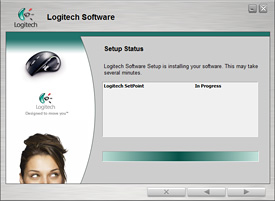 |
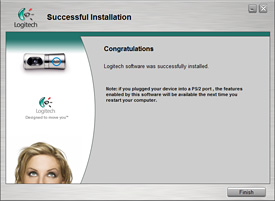 |
| Click to enlarge | |
Logitech ships version 3.3a of their SetPoint software suite in the current G5 package. Based upon our early testing in Vista, we just recommend using the CD as a platter and instead download version 4.00 before you use the mouse although the basic mouse functions work fine with the included drivers. Logitech's software installation is painless, but required about 58MBs of disk space, and also searched for other Logitech hardware for updates. The software supports Windows XP, XP-64 Edition, Vista 32 or 64-bit, and MacOS X. The basic mouse functions worked fine in SUSE Linux 10.2 but SetPoint is not compatible with Linux at this time.
The primary purpose of SetPoint is to allow complete control over the mouse's hardware capability. The interface is fairly intuitive and the programs offers a dizzying array of options to control the wheel and various buttons on the mouse. This includes an informative status display for checking the dpi and USB polling rates in the gaming section . While we could spend pages on describing and showing each setting we will simply display the configuration windows and recap any major items of interest we discovered during testing.
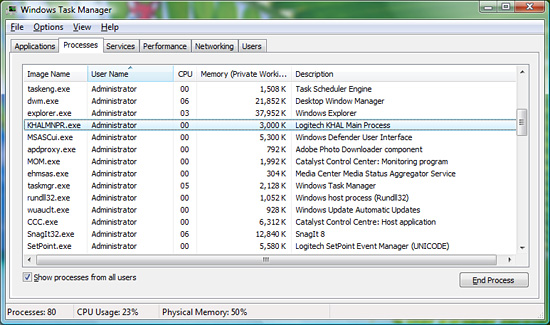 |
| Click to enlarge |
Once we loaded the software and rebooted, our first order of business was to understand how memory hungry the SetPoint application and associated software is in Vista Home Premium. The results were surprising when compared to our MX Revolution that consumed around 18MB of memory when active. Our two Logitech programs, Khalmnpr.exe and Setpoint.exe, consumed a total of 8.5MB of memory in idle state and 12MB of memory while active. CPU usage was nominal during all phases of testing although we have heard reports of reduced frame rates in some configurations.
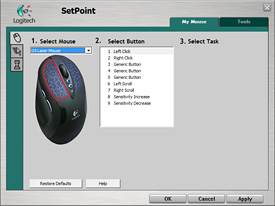 |
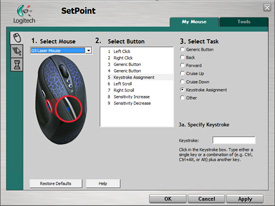 |
| Click to enlarge | |
The first option screen allows the user to define the function of the scroll wheel along with each button except for the right and left click buttons. A listing of the more common commands is listed at the right of the screen with additional options available if you choose the "Other" option. Each configurable button on the mouse has its own display screen and option choices. Logitech highlights and provides a picture zoom of the button or wheel you are adjusting. If you want the mouse to follow a different set of commands in a particular program then you simply select the supported program from a drop-down list and reassign the buttons. This feature is probably one of the most widely used and if the program is not available you can manually add it.

The Mouse Movement section allows for pointer adjustments and is quicker to use than the standard Windows mouse option screen.

The Mouse Game Settings section allows for OS or SetPoint control of basic speed, acceleration, and button settings if a game is automatically detected.

The Advanced Game Settings section allows for complete control over Mouse Sensitivity along with USB (refresh rates) reports per second settings. You can configure up to five different dpi sensitivity settings between 400 and 2000 DPI although only three are available for the button assignments. You can also set the horizontal and vertical sensitivities separately. USB reports per second settings are available from 125 up to 1000 in six different rates. The mouse defaults to 500, a number we found was just about perfect from both a performance and compatibility aspect across a wide range of systems. The SetPoint software will setup basic profiles for games that it recognizes. These profiles can then be customized or you can setup individual profiles for games that are not recognized.










39 Comments
View All Comments
cjb110 - Wednesday, July 25, 2007 - link
The weight system is a good idea in principle, but the with the current setup the weight difference isn't noticable. They need to have a greater range, say adding upto 100g, rather than the paltry 36g.yacoub - Wednesday, July 25, 2007 - link
Eagerly awaits an article about modding the G5 by cutting your own lead weights for uber weight advantage / wrist building scheme. ^^Deusfaux - Wednesday, July 25, 2007 - link
This is another major issue with past mice like the G5 that have sideways middle clicks.Did you guys experience a lot of incorrect button presses when attempting to do a middle click? ie, did you hit middle left or right instead or AS WELL as hitting the middle?
With the MX518 hitting the middle click is easy and always guaranteed...
Gary Key - Friday, July 27, 2007 - link
We did not have any incorrect middle clicks during testing. The main reason is the fact that you have to firmly press down on the middle button which made reaction time slower to some degree until you get use to it. I prefer the MX518 middle click but several others liked the G5.Capt Caveman - Wednesday, July 25, 2007 - link
I find that using the right/left tilt buttons on the middle wheel to be faster and more useful than the second thumb button and middle wheel button.MX518 - second thumb button/more responsive middle wheel button = right/left tilt buttons on middle wheel of G5/G7
Nullvoid - Wednesday, July 25, 2007 - link
That you received some new 'Razer' units not RAZOR.flyboy84 - Wednesday, July 25, 2007 - link
...you are correctandepro - Wednesday, July 25, 2007 - link
Did any1 come across this article?:
http://www.esreality.com/?a=post&id=1265679">http://www.esreality.com/?a=post&id=1265679
Gary Key - Friday, July 27, 2007 - link
We had been working on something similar but decided in the end that the amount of testing required for each mouse (G5 as an example, 3dpi/6 USB polling settings x various weight points plus multiple path movements) still would not really tell us anything conclusive about how the mouse operates without knowing the conditions it would be used in. We are still figuring out how to do something more scientific while trying to cover the major variables.
strafejumper - Wednesday, July 25, 2007 - link
have seen it, this esreality article is not perfect, but way beyond any other mouse reviews i've seen anywhere.its written by competitive multiplayer gamers for competitive multiplayer gamers.
haven't read it in a long time but i believe one of the things it covered that really no one else does is negative acceleration. Negative acceleration meaning if you move the mouse x distance at a slow speed, it tracks differently than if you move the mouse the same distance at a fast speed. I would have liked them to test a ball mouse to see if it has any negative acceleration.